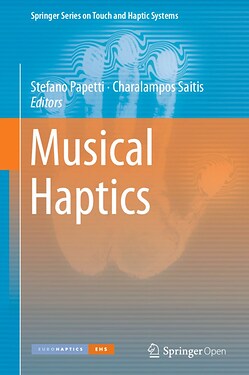I ran across this compilation of open source research papers related to the “Feel” of musical instruments. The price of this one volume of an expensive 18 book series is $0.
Some topics included:
- An in depth examination of the physics of the piano action.
- Bulk Mechanics of the Fingertip and the Skin - (physical characteristics of a flash hammer)
- There are digital instrument interface designs, including an active simulation of a piano keys.
- 5.2.1 Touch and the Conceptualization of Violin Quality by Musicians (Fig 5.2 Lists 7 qualities defining playability ‘feel’)
- 6.2.2 Fitts’ Law is used in HCI to describe the relationship between time, distance and target size when performing rapid aimed movements.
You can get the free Kindle version from Amazon.
Here’s a direct PDF download link. (obscure file name: 1001852.pdf)
The Chapters:
Part I Interaction and Perception
- Once More, with Feeling: Revisiting the Role of Touch in Performer-Instrument Interaction.
- A Brief Overview of the Human Somatosensory System
- Perception of Vibrotactile Cues in Musical Performance
- The Role of Haptic Cues in Musical Instrument Quality Perception
- A Functional Analysis of Haptic Feedback in Digital Musical Instrument interactions
- Auditory-Tactile Experience of Music
Part II Haptic Musical Interfaces: Design and Applications
- The MSCI Platform: A Framework for the Design and Simulation of Multisensory Virtual Musical Instruments
- Force-Feedback Instruments for the Laptop Orchestra of Louisiana
- Design of Vibrotactile Feedback and Stimulation for Music Performance
- Haptics for the Development of Fundamental Rhythm Skills, Including Multi-limb Coordination
- Touchscreens and Musical Interaction
- Implementation and Characterization of Vibrotactile Interfaces
ISBN 978-3-319-58316 . . . ISSN 2192-2985 (electronic)
The complete Springer Series on Touch and Haptic Systems (18 books) Kindle version sells for $788.08 !!
Some of us may have experienced subtle haptic feedback with better cell phone and smart watches. There is more advanced touch screen technology allowing the blind to ‘feel’ dynamically changing shapes.
BONUS: Prosthesis EMG (electromyography) Sensor used as Synth CV output.
“Hacking my arm prosthesis to output CV so that it plugs into my synth: Thought-controlled music!”
Video starting at 5:16 , where the hands on application is demonstrated, start from start for background story. (Came up in a search for ARM Processor compatible talk)
.
UPDATE:
SynLimb arm prosthesis to synthesizer CV controller hack update: Thank you, case design, practice.


